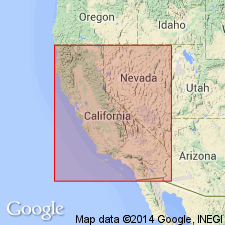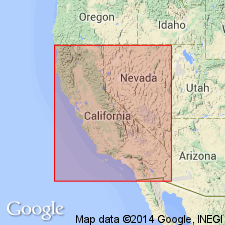
- Usage in publication:
-
- Stewarts Point Member
- Modifications:
-
- Named
- Dominant lithology:
-
- Arkose
- AAPG geologic province:
-
- California Coast Ranges province
Summary:
Two synchronous members distinguished in Gualala Formation (rank herein reduced from group to formation) are (ascending) are Stewarts Point and Anchor Bay Members. [Type not designated.] Stewarts Point Member is characterized by gray-white arkose rich in potassium feldspar. Is considered Late Cretaceous age.
Source: GNU records (USGS DDS-6; Menlo GNULEX).

- Usage in publication:
-
- strata of Stewarts Point
- Modifications:
-
- Biostratigraphic dating
- AAPG geologic province:
-
- Northern Coast Range province
Summary:
strata of Stewarts Point. [Name Stewarts Point "Member" not used.] Gualala Group of Weaver (1943) divided into three mappable units (ascending), informally called: strata of Stewarts Point, strata of Anchor Bay, and strata of German Rancho. Strata of Stewarts Point consist of gray-white K-feldspar arkose, gray-black mudstone, and conglomerate with exposed thickness of 4,400 feet. Interfingers with and underlies strata of Anchor Bay. In fault contact with underlying spilite near Black Point. Fossils sparse. Foraminifers diagnostic of Goudkoff's E zone (Popenoe and others, 1960) indicate age near Campanian-Maestrichtian boundary.
Source: Modified from GNU records (USGS DDS-6; Menlo GNULEX).
For more information, please contact Nancy Stamm, Geologic Names Committee Secretary.
Asterisk (*) indicates published by U.S. Geological Survey authors.
"No current usage" (†) implies that a name has been abandoned or has fallen into disuse. Former usage and, if known, replacement name given in parentheses ( ).
Slash (/) indicates name conflicts with nomenclatural guidelines (CSN, 1933; ACSN, 1961, 1970; NACSN, 1983, 2005, 2021). May be explained within brackets ([ ]).

